They were the King and Queen of Film Noir: Humphrey DeForest Bogart and Lauren “Betty” Bacall. He was insolent and tough; she was insolent and beautiful, and they made dark, wonderful, wise-cracking music together – in a noir world of shadowy streets, nightclubs, guns, crooks, cops, cigarettes, whiskey, trench coats (for him) and evening gowns (for her).
Archives for August 2012
The Noir File: The Great Film Noir Couple: Bogart and Bacall
They were the King and Queen of Film Noir: Humphrey DeForest Bogart and Lauren “Betty” Bacall. He was insolent and tough; she was insolent and beautiful, and they made dark, wonderful, wise-cracking music together – in a noir world of shadowy streets, nightclubs, guns, crooks, cops, cigarettes, whiskey, trench coats (for him) and evening gowns (for her).
Book ’em: Parry, Keller, Kardos, Braver, Baker, Winter, Black, Nakamura, Lehane, Vincelette
Lately I’ve been getting up a little earlier than usual so I that I can read a few pages of a good book as I drink my morning coffee. It’s a lovely way to start a morning, assuming you’re into murder and the dark mysteries of the human heart. In the past few weeks, I’ve been lucky – there’s a feast of new books to choose from. I’m making progress on many of these titles and plan to run full reviews in upcoming posts.
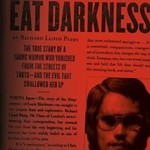
 “People Who Eat Darkness” by Richard Lloyd Parry (FSG, $16) A British journalist’s unforgettable account of a true crime that took place in Tokyo in 2000: the disappearance and murder of bar hostess Lucie Blackman, just 21 when she died.
“People Who Eat Darkness” by Richard Lloyd Parry (FSG, $16) A British journalist’s unforgettable account of a true crime that took place in Tokyo in 2000: the disappearance and murder of bar hostess Lucie Blackman, just 21 when she died.
“A Killing in the Hills” by Julia Keller (Minotaur, $24.99) Keller, a Pulitzer Prize-winning journalist (Chicago Tribune), crafts a spellbinding murder mystery set in her home state of West Virginia.

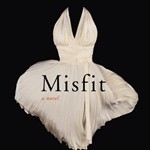 “The Three-Day Affair” by Michael Kardos (The Mysterious Press, $24) A debut thriller about three longtime friends who make one mistake, forcing a chain of decisions that will haunt them forever.
“The Three-Day Affair” by Michael Kardos (The Mysterious Press, $24) A debut thriller about three longtime friends who make one mistake, forcing a chain of decisions that will haunt them forever.
“Misfit” by Adam Braver (Tin House Books, $15.95) Braver gives a literary, imaginative rendering of the final days of Marilyn Monroe, who died Aug. 5, 1962 in her Brentwood home.
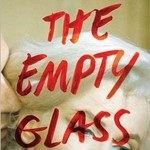
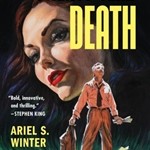 “The Empty Glass” by J.I. Baker (Blue Rider Press, $25.95) The LA County deputy coroner discovers Marilyn Monroe’s secret diary and starts to probe the sad and sinister details of the star’s death in this first-time novel by a veteran magazine journalist.
“The Empty Glass” by J.I. Baker (Blue Rider Press, $25.95) The LA County deputy coroner discovers Marilyn Monroe’s secret diary and starts to probe the sad and sinister details of the star’s death in this first-time novel by a veteran magazine journalist.
“The Twenty-Year Death” by Ariel S. Winter (Hard Case Crime, $25.99) A mystery divided into three sections. Part one, set in 1931, is an homage to the marvelously prolific French author Georges Simenon. Part two takes place in 1941 and honors noir great Raymond Chandler. And last the darkly compelling Jim Thompson gets his due in a 1951 setting.
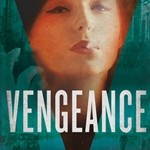
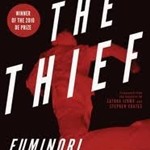 “Vengeance” by Benjamin Black (Henry Holt, $26) A Dublin-based pathologist finds himself in the middle of a battle between two families. Noir with a 1950s Irish twist by this Booker prize-winning author (aka John Banville).
“Vengeance” by Benjamin Black (Henry Holt, $26) A Dublin-based pathologist finds himself in the middle of a battle between two families. Noir with a 1950s Irish twist by this Booker prize-winning author (aka John Banville).
“The Thief” by Fuminori Nakamura (Soho Press, $23) The first novel by the celebrated Japanese author to be translated into English, “The Thief” is a minimalist sliver of Tokyo noir told in the first person by an anonymous pickpocket, says Laura Wilson of the Guardian newspaper. As she puts it: “This isn’t for those who prefer the conventional crime novel. It is, however, an intelligent, compelling and surprisingly moving tale, and highly recommended.”
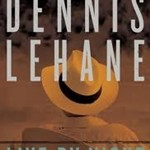
 “Live by Night” by Dennis Lehane (Morrow, $27.99) According to Publishers Weekly, Warner Bros. and Leonardo DiCaprio have optioned the film rights to this police saga set in Prohibition-era Boston. (Releases Oct. 2)
“Live by Night” by Dennis Lehane (Morrow, $27.99) According to Publishers Weekly, Warner Bros. and Leonardo DiCaprio have optioned the film rights to this police saga set in Prohibition-era Boston. (Releases Oct. 2)
“Polynie” by Melanie Vincelette (McArthur & Co., $18.95) This novel about a lawyer whose body is discovered in the hotel room of a stripper was shortlisted for a Governor General’s literary award when it appeared in French, according to Quill & Quire. An English-language version will appear in November.
Bobbi Brown, Leandra Medine to host FNO event in NYC
Just found out about a very cool Fashion’s Night Out event in New York. Bobbi Brown is teaming up with Leandra Medine, founder of The Man Repeller, at an ideal venue to talk shop: Brown’s pop-up shop in Grand Central Terminal.
Medine explains the MR concept as follows: “outfitting oneself in a sartorially offensive mode that may result in repelling members of the opposite sex. Such garments include but are not limited to harem pants, boyfriend jeans, overalls (see: human repelling), shoulder pads, full length jumpsuits, jewelry that resembles violent weaponry and clogs.”
At the shop, Brown and Medine will talk with customers about makeup and fashion trends, and makeup artists will provide complimentary applications. Additionally, customers will get an exclusive preview of Bobbi Brown Red Carpet Creamy Matte Lip Color ($24; otherwise available in October.) Only 500 will be released, adorned with a special FNO insignia.
The event is from 7 to 8 p.m. on Tuesday, Sept. 6, at the Bobbi Brown Cosmetics Pop-Up Shop, Grand Central Terminal, Lexington Corridor, 87 E. 42nd St., New York, NY 10017, 212-867-5168.
Don’t stay in on Fashion’s Night Out: Next Thursday
 On Thurs., Sept. 6, fashionistas will be out in full force for an evening of power-shopping as Fashion’s Night Out returns for its fourth year.
On Thurs., Sept. 6, fashionistas will be out in full force for an evening of power-shopping as Fashion’s Night Out returns for its fourth year.
Where is it? Check the site to find out what’s going on in your city. Last year’s bash featured more than 4,500 events in the U.S. and worldwide 18 countries took part. With special limited-edition products, celebrity appearances and performances, FNO 2012 offers much to entice.
Forty percent of proceeds raised from sales of FNO T-shirts and totes will go to the New York City AIDS Fund in the New York Community Trust, according to FNO.
The Noir File: As time goes by, ‘Casablanca’ remains sublime
By Michael Wilmington
A noir-lover’s guide to classic film noir on cable TV. All the movies listed below are from the current schedule of Turner Classic Movies (TCM), which broadcasts them uncut and uninterrupted. The times are Eastern Standard and (Pacific Standard).
PICK OF THE WEEK
“Casablanca” (1942, Michael Curtiz) Wednesday, Aug. 29, 10 p.m. (7 p.m.) On the Warner Brothers back lot, in an exotic city that hums with intrigue, we watch one of the movies’ immortal affairs and grandest pictures: “Casablanca” is, in some respects, the perfect Hollywood Golden Age studio movie.
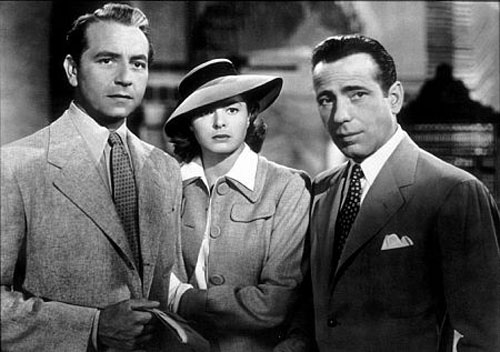
Stuck in the middle: Ilse (Ingrid Bergman) is torn between duty (Paul Henreid) and love (Humphrey Bogart) in “Casablanca,” one of the best Hollywood Golden Age studio movies.
We see the frustrated and tormented but finally sublime passion of gloomy hard-case cabaret owner Rick (Humphrey Bogart, in his most popular role) for scared, on-the-run Ilse (Ingrid Bergman, in hers). Ilse is the emotionally torn woman of mystery whom Rick loved and lost, the angel who won his heart and left him in Paris. She now belongs body and soul, it seems, to the idealistic underground anti-Fascist leader Victor Laszlo (Paul Henreid). Around them swirl the ideological storms of Nazi-ravaged Europe, at least as Warners saw them.
And backing them up is one of the all-time great Hollywood supporting casts: Claude Rains as the suave and lecherous Vichy police head Renault; Conrad Veidt as the elegant, murderous Nazi commander Strasser; Sydney Greenstreet as the vaguely sinister rival cabaret owner; Peter Lorre as Ugati, the rat with the papers; S. Z. “Cuddles” Sakall as the lovable fat busybody; Marcel Dalio as the nimble croupier; Curt Bois as the ferret-like pickpocket (“Vultures everywhere!”); and of course that indefatigable piano man Sam (Dooley Wilson) – the fellow who plays (or doesn’t) “As Time Goes By.”
“Casablanca,” which expertly melds several key ’40s Hollywood genres (drama, comedy, noir, spy thriller, love story) was adapted from a truly lousy play “Everybody Goes to Rick’s,” reworked by the Epstein brothers (Julius and Philip) and Howard Koch, and directed by that sometimes underrated master, Michael Curtiz. A big hit in its day and also a multiple Oscar winner, this picture has never stopped pleasing and rousing audiences. It probably never will. (Also available in Warners’ three-disc 70th anniversary edition DVD and Blu-ray.)
Saturday, Aug. 25: Tyrone Power Day
2:30 a.m. (11:30 p.m.): “Witness for the Prosecution” (1957, Billy Wilder) From the famous Agatha Christie short story, Billy Wilder expertly fashions one of the screen’s trickiest trial-drama/murder mysteries – with Charles Laughton as the wily, wheelchair-bound barrister, his real-life wife Elsa Lanchester as his long-suffering nurse, and Tyrone Power and Marlene Dietrich as the incendiary couple caught up in a legendary triple-reverse surprise ending.
Tuesday, Aug. 28: Ava Gardner Day
10:45 p.m. (7:45 p.m.): “The Bribe” (1949, Robert Z. Leonard) Robert Taylor, Ava Gardner, Charles Laughton and Vincent Price in the smoky noir tale of a federal guy and a femme fatale. A lot of it wound up in the 1982 Steve Martin–Carl Reiner film noir parody “Dead Men Don’t Wear Plaid.”
Wednesday, Aug. 29: Ingrid Bergman Day
6 p.m. (3 p.m.): “Gaslight” (1944, George Cukor) Set in foggy Victorian gas-lit London, this is the best of all the melodramas and noirs where a bad husband tries to drive his wife insane (or vice versa). Here, Charles Boyer gives the treatment to Oscar-winner Ingrid Bergman. Joseph Cotten, Dame May Whitty and teenage Angela Lansbury are among the bystanders. Based on the Patrick Hamilton stage play (and film) “Angel Street.”
Will ‘Compliance’ have you screaming at the screen?
 Compliance/2012/Magnolia Pictures/90 min.
Compliance/2012/Magnolia Pictures/90 min.
“Compliance” – a disturbing psychological thriller – will more than likely draw extreme reactions from its audiences. One response it probably won’t trigger is boredom. Taut and intense as well as unhurried and detached, it’s a film that, for every one of its 90 minutes, grips, fascinates and frightens.
The story starts on preposterous note and from there it gets even more absurd. The manager of a fast-food restaurant in suburban Ohio (Ann Dowd) receives a call from a man (Pat Healy) who identifies himself as a cop. He tells her that a customer has accused one of the restaurant’s employees, a cartoonishly pretty 19-year-old named Becky (Dreama Walker), of stealing money.
The officer then asks the manager to help with the investigation and to strip-search Becky. Both she and Becky put up little resistance to the caller’s requests (“I’m just trying to do my job,” they both say at different times). After they acquiesce to the initial requests, the caller’s demands become more outrageous and bizarre. At one point, Becky agrees to do jumping jacks, naked.
What’s most unnerving is that “Compliance” is based on real events that took place in a suburb of Louisville, Kentucky, in 2004. And that was not an isolated incident: about 70 similar calls (in which a police officer was impersonated) were made throughout the country in a 10-year period.
But the film is not a documentary. “The reason to make the movie is to fill in the gaps in reality,” said director Craig Zobel at a recent roundtable. “I was very scared to make this movie. If we were going to do it right, we were going to have to ask some hard questions. And the movie doesn’t work for everyone.”
A colleague and friend of mine found the movie exploitative. “The only legitimate reaction is to walk out,” he said and in fact a few people did at the screening we attended.
Watching the humiliation unfold, the kneejerk reaction is to ask: “What is wrong with these people? Why are they going along this?” Yet not only did a version of these events actually happen, repeated psychological studies have shown that, more often than not, most people will obey authority and follow instructions, even if they are asked to do something they know is wrong.
And of course the next question is: “What would I do in that situation?” Your answer to that is perhaps the best way to judge the film’s merits. If you find yourself feeling superior (“I’d never do that”), the film has missed its mark. If, however, you feel sympathy for the characters, the film succeeds.
As Walker put it at the roundtable: “Who knows what any of us would do in that situation? It’s a very primal question.”
“Compliance” opens today in Los Angeles. Filmmaker Craig Zobel and actor Pat Healy will attend shows this weekend at the Nuart Theatre.
Seeking ‘recline’ inspiration from film noir’s injured characters
I recently experienced a little setback: I fractured my toe (one in from the pinkie on the right foot). I didn’t teeter as I tried on Loubou’s or tumble on a treacherous chunk of pavement. Nor was I hang-gliding or training for a 5k run. Please. Have we met? No, in typical femme fatale fashion, à la Mae West, I tripped over a pile of men.
Of course I don’t mind being ordered by doctors to rest and relax. In fact, I relish the opportunity. And if ever there were a time to be waited on hand and foot, bark out orders and be completely catered to, honey this is it! I’m also grateful that the toe (underrated little body part that it is) wasn’t broken or more severely damaged – it should heal nicely as long as I’m patient.
But the thing I really miss is going to yoga. Feeling a little blue and kicking myself (pun intended) for not being more careful, I called my friend Anne who pointed out that what’s bad in life is good on the page. She suggested that as I recuperate I commiserate with noir characters – like nostril-impaired Jake Gittes (Jack Nicholson) in “Chinatown” – who sustain and recover from injuries. (You can always trust a Gemini to come up with a creative approach.)
As I lounge on my sofa, I also find myself pondering existential questions, such as: Can I now fulfill my long-held fantasy of going to yoga and resting in child’s pose for the entire class? Will wine and ice cream provide the same benefits as shavasana? What about cupcakes? Does Susie Cakes deliver? Is it possible to dance while using crutches? How long can a girl go without shaving her legs?
Aah, more than my peabrain can process right now. So, with many thanks to Anne, here are my favorite mending moments of film noir.
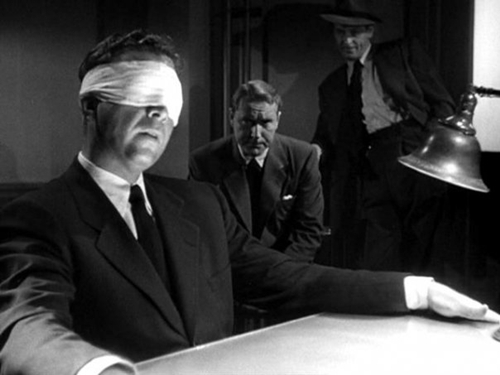 Dick Powell as Philip Marlowe is temporarily blinded in “Murder, My Sweet.”
Dick Powell as Philip Marlowe is temporarily blinded in “Murder, My Sweet.”
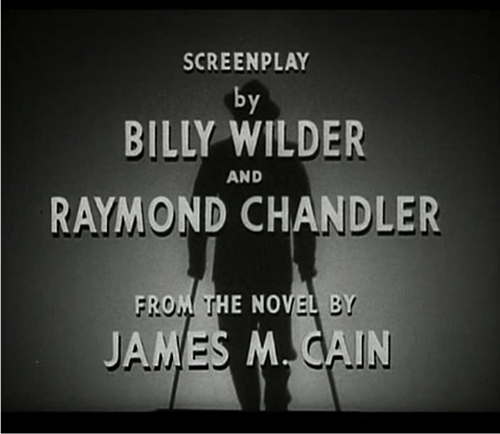 Phony, schmony. The dude still hobbled around on crutches: Fred MacMurray in “Double Indemnity.”
Phony, schmony. The dude still hobbled around on crutches: Fred MacMurray in “Double Indemnity.”
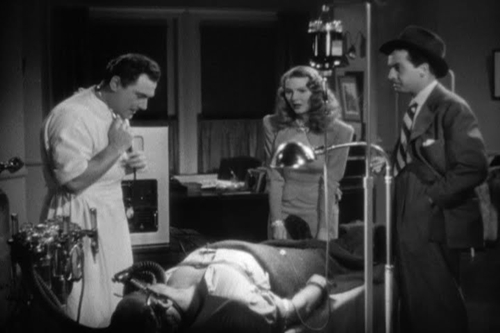 “Decoy”’s Frank Armstrong recovers from the ultimate “accident.” Cold-hearted Jean Gillie sees a way to get her hands on a wad of cash by bringing her criminal boyfriend back to life following his visit to the gas chamber. Absurd? Absolutely. Still, it’s all in a day’s work for film noir’s toughest femme fatale.
“Decoy”’s Frank Armstrong recovers from the ultimate “accident.” Cold-hearted Jean Gillie sees a way to get her hands on a wad of cash by bringing her criminal boyfriend back to life following his visit to the gas chamber. Absurd? Absolutely. Still, it’s all in a day’s work for film noir’s toughest femme fatale.
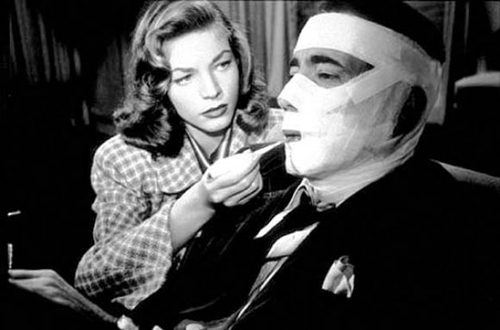 “Dark Passage”: Unjustly sentenced prison escapee Humphrey Bogart undergoes plastic surgery to alter his looks. He co-stars with real-life wife Lauren Bacall.
“Dark Passage”: Unjustly sentenced prison escapee Humphrey Bogart undergoes plastic surgery to alter his looks. He co-stars with real-life wife Lauren Bacall.
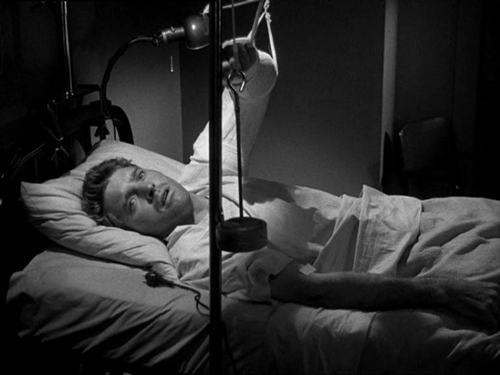 Burt Lancaster sustains major injuries after a heist gets fouled up in “Criss Cross.” (In “The Killers” Lancaster plays a boxer whose career folded after hurting his hand.)
Burt Lancaster sustains major injuries after a heist gets fouled up in “Criss Cross.” (In “The Killers” Lancaster plays a boxer whose career folded after hurting his hand.)
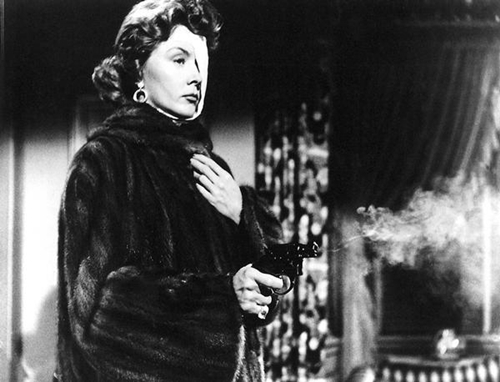 “The Big Heat” contains one of film noir’s most famous violent scenes. Lee Marvin throws a pot of boiling coffee at Gloria Grahame and disfigures her face. She gets even in the end.
“The Big Heat” contains one of film noir’s most famous violent scenes. Lee Marvin throws a pot of boiling coffee at Gloria Grahame and disfigures her face. She gets even in the end.
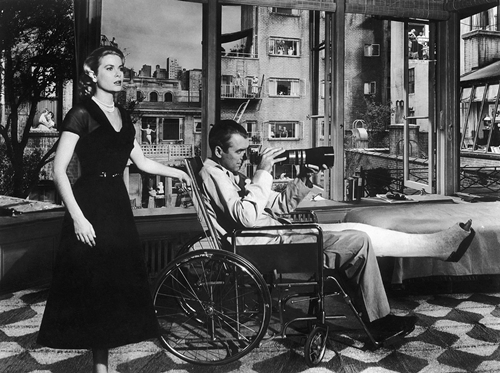 Jimmy Stewart is a photojournalist who watches his neighbors to pass the time (with gorgeous Grace Kelly for company) while his leg heals in “Rear Window.”
Jimmy Stewart is a photojournalist who watches his neighbors to pass the time (with gorgeous Grace Kelly for company) while his leg heals in “Rear Window.”
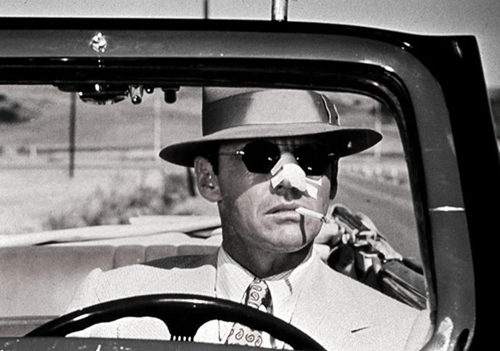 Jack Nicholson wears his bandage for most of “Chinatown.” Director Roman Polanski plays the menacing punk who cuts Nicholson’s nose.
Jack Nicholson wears his bandage for most of “Chinatown.” Director Roman Polanski plays the menacing punk who cuts Nicholson’s nose.
 “Misery”’s Kathy Bates is the nurse-from-hell to wounded writer James Caan.
“Misery”’s Kathy Bates is the nurse-from-hell to wounded writer James Caan.
![251[1]](http://www.filmnoirblonde.com/wp-content/uploads/2012/08/2511.jpg) Viggo Mortensen gets stabbed in his foot after fending off two thugs in “A History of Violence.”
Viggo Mortensen gets stabbed in his foot after fending off two thugs in “A History of Violence.”
The Noir File: ‘Top of the World, Ma!’ and more classic Cagney moments
By Michael Wilmington
A noir-lover’s guide to classic film noir on cable TV. All the movies listed below are from the current schedule of Turner Classic Movies (TCM), which broadcasts them uncut and uninterrupted. The times are Eastern Standard and (Pacific Standard).
PICK OF THE WEEK
“White Heat” (1949, Raoul Walsh): Tuesday, Aug. 14, 10 p.m. (7 p.m.) “Top of the world, Ma!” James Cagney screams, in one of the all-time great noir performances and last scenes. Cagney’s character (one of his signature roles) is Cody Jarrett, a psycho gun-crazy gangster with a mother complex, perched at the top of an oil refinery tower about to blow.
Edmond O’Brien is the undercover cop in Cody’s gang, Virginia Mayo is Cody’s faithless wife, and Margaret Wycherly is Ma. One of the true noir masterpieces, “White Heat” boasts another classic, hair-raising scene: Cagney’s crack-up in prison when he hears of Ma’s death. Script by Ivan Goff and Ben Roberts; music by Max Steiner. At 7 p.m. (4 p.m.), preceding “White Heat” and “City for Conquest” is the documentary “James Cagney: Top of the World,” hosted by Michael J. Fox.
Friday, Aug. 10
12 a.m. (9 p.m.): “Key Largo” (1948, John Huston) Humphrey Bogart and Edward G. Robinson are pitted against each other in this tense adaptation of the Maxwell Anderson play. Bogie is a WW2 vet held hostage (along with Lauren Bacall and Lionel Barrymore) during a tropical storm by brutal mobster Robinson and his gang. Claire Trevor, as a fading chanteuse, won the Best Supporting Actress Oscar.
Saturday, Aug. 11
8 p.m. (5 p.m.): “Lolita” (1962, Stanley Kubrick, U.S.-Britain) Kubrick’s superb film of Vladimir Nabokov’s classic comic-erotic novel – about the dangerous affair of college professor Humbert Humbert (James Mason) with nymphet Lolita (Sue Lyon), while they are nightmarishly pursued by writer/sybarite Clare Quilty (Peter Sellers). It has strong noir touches, themes and style. With Shelley Winters; script by Nabokov (and Kubrick).
Tuesday, Aug. 14
7:30 a.m. (4:30 a.m.) “The Public Enemy” (1931, William Wellman) Quintessential pre-noir gang movie, with Cagney, Jean Harlow, Mae Clarke, booze, guns and a grapefruit.
12 p.m. (9 a.m.): “Each Dawn I Die” (1939, William Keighley) Cagney and George Raft in prison. Reportedly one of Joseph Stalin’s favorite movies.
Wednesday, Aug. 15
1 a.m. (10 p.m.): “The Night of the Hunter” (1955, Charles Laughton) The great noir with Robert Mitchum as evil Preacher Harry, Lillian Gish and Shelley Winters.
‘Nuit #1’ is a daring, if flawed, study of a one-night stand
![Nuit_1[1]](http://www.filmnoirblonde.com/wp-content/uploads/2012/08/Nuit_111-191x300.jpg) Nuit #1/2011/Adopt Films/91 min.
Nuit #1/2011/Adopt Films/91 min.
“Nuit #1” – a fly-on-the-wall treatment of a one-night stand – doesn’t hold much back. It begins with the eerily glum intensity of the rave where Clara (Catherine de Léan) and Nikolai (Dimitri Storoge) meet, moves to clinical coverage of them having sex at Nikolai’s dumpy apartment, then lingers on their scathingly honest exchanges about the reality of their lives – the frustration, pain and desperation that exist just beneath the surface.
They are strangers who share a random spark of chemistry, then take turns sharing their angst in a series of monologues. He’s broke, angry and can’t hold a job; modern love makes him sick, he declares. She’s a school teacher who relieves her unhappiness through partying and nights with other strangers.
Playlike in its structure, “Nuit #1” sometimes feels too talky, the unhappy characters border on clichéd. Still, Canadian writer/director Anne Émond, 29, shows confidence as a director, eliciting raw, spontaneous and resonant performances from her actors. She takes intelligent risks and is at times thoughtfully provocative.
It seems safe to say that Émond had “La maman et la putain”/“The Mother and the Whore” (1973, Jean Eustache) on her radar as she made this film. Wonder if David Lean/Noel Coward’s “Brief Encounter” (1945), one of my favorite ill-fated romances, also made her viewing list? ; )
“Nuit #1” opens today at Landmark’s Nuart Theatre in Los Angeles.
![bogie and bacall[1]](http://www.filmnoirblonde.com/wp-content/uploads/2012/08/bogie-and-bacall1.jpg)
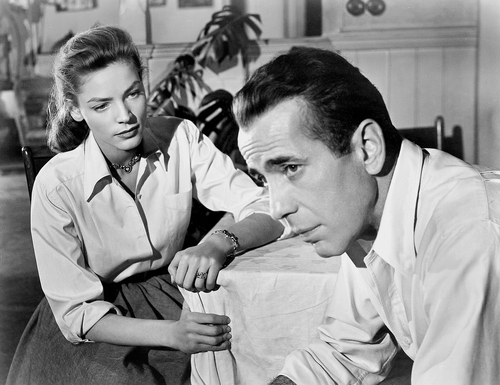
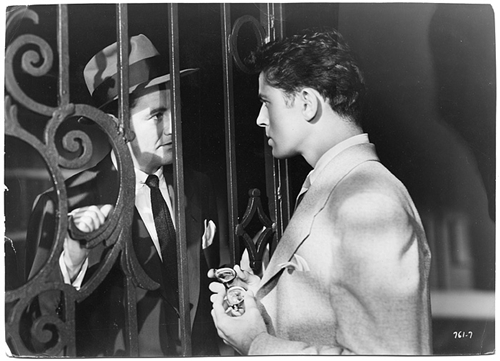






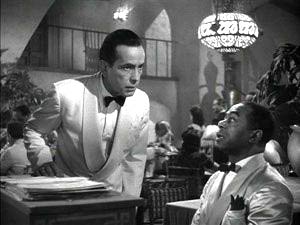
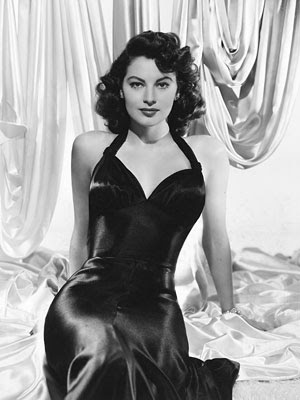
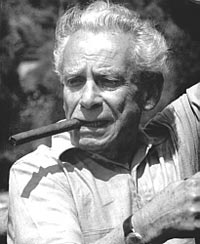
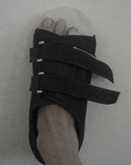
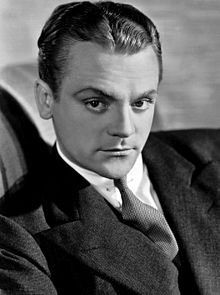
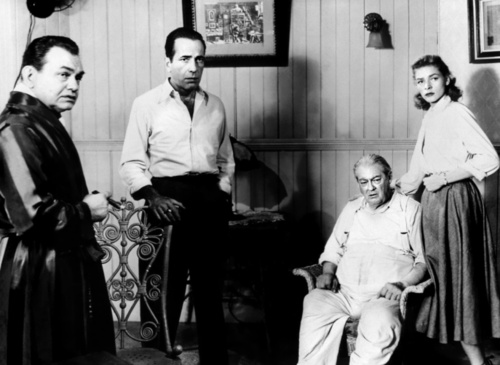





From FNB readers